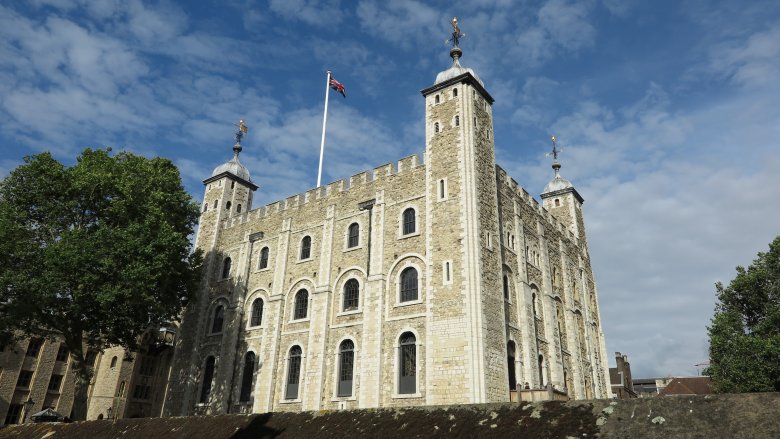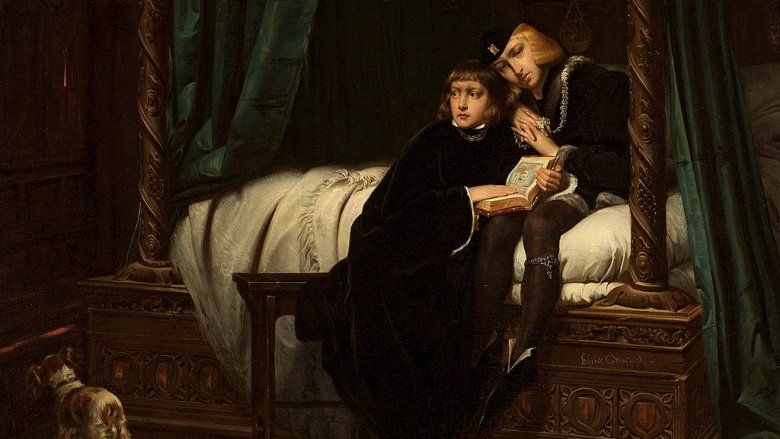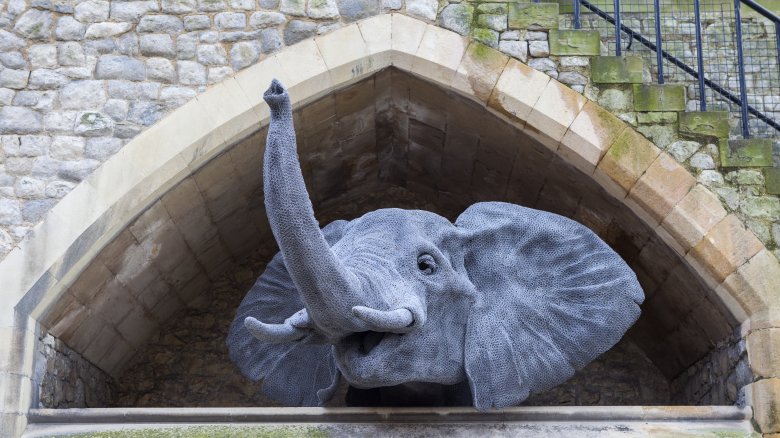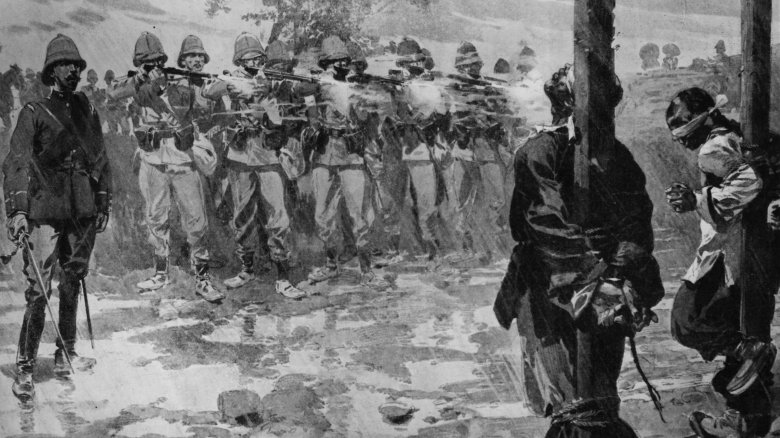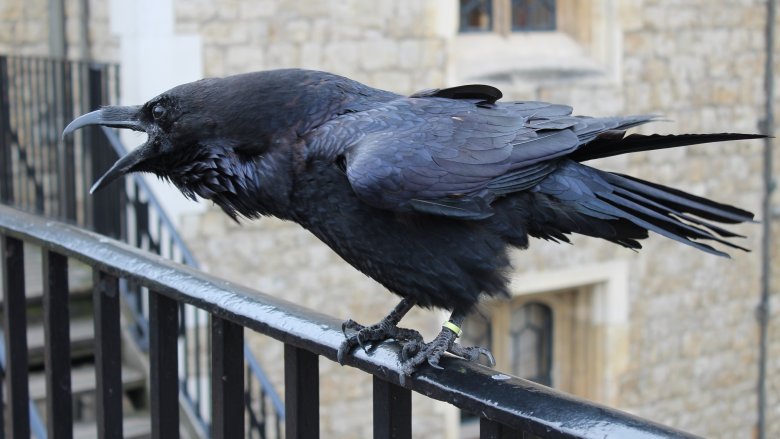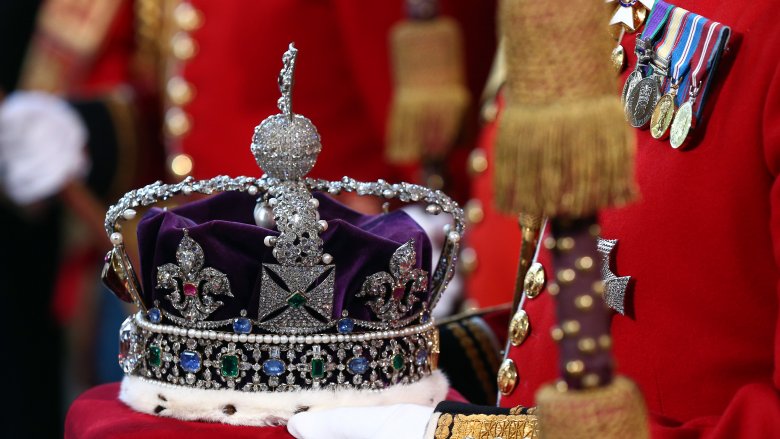Messed Up Things That Happened At The Tower Of London
Commissioned in 1078 by William the Conqueror, the Tower of London is one of the most messed up places in the history of England's messed up places. More than 100 people were put to death at the Tower during its 900-year history, and countless others were imprisoned or tortured there.
Most of the messed up things that happened at the Tower of London during its long and sordid history had to do with someone's head getting chopped off, but there were a few other things that were just woefully strange. Here are some of the most notable.
Executions of noblewomen
The executioner's ax didn't discriminate — kings and queens killed pretty much anyone who annoyed them, whether it was a 16-year-old child or a 67-year-old woman. According to English Monarchs, Henry VIII, the boiled ham who ruled England for an agonizingly long period of time, had two of his wives executed at the Tower of London, but he was super merciful so he had their heads chopped off in private on Tower Green instead of in public just outside on Tower Hill. His second wife, Anne Boleyn, was executed for the crime of being stupid enough to marry an angry boiled ham, and his fifth wife, Catherine Howard, was executed for the crime of being stupid enough to marry an angry boiled ham who had already had one of his previous wives executed.
And because Henry was that kind of boiled ham, he wasn't above executing old ladies, either. Margaret Pole was 65 years old when she was taken to the Tower for the awful crime of being related to someone who once said something that Henry didn't like. At the age of 67, she was marched down to Tower Green and put to death by an executioner who didn't know what the heck he was doing and had to swing the ax not twice but 11 times before the poor old woman was actually declared dead. The takeaway from this story: boiled hams make terrible leaders.
The princes in the Tower
Before Henry VIII there was Richard III, who may or may not have been unfairly portrayed as a villain by William Shakespeare. (It's worth noting that Shakespeare kind of had to say bad things about Richard because the Tudor Queen Elizabeth, like her boiled ham father before her, was fond of chopping heads off and wouldn't have been thrilled to see the guy her family had usurped played as anything less than a "bunch-backed toad.")
Among the crimes Richard may or may not have committed was the murder of his nephews. According to the BBC, the two princes were taken to the Tower not long after the death of their father, Edward IV. Shortly thereafter they were declared illegitimate, their uncle was crowned king, and the boys were never heard from again.
Now granted, that does look pretty bad for Richard, but consider this: Richard only reigned for a couple years, and if the boys were still alive after he was defeated by the first Tudor king Henry VII, well, they would have been a problem for the new king — so it seems just as likely that Henry had the boys murdered. What we do know is that we may never know because the two skeletons found in 1674 probably won't ever be disinterred for further investigation. "I do not believe we are in the business of satisfying curiosity," said the dean of Westminster, when asked to explain why a possibly solvable mystery shall remain forever unsolved. Whatever.
Death by Malmsey wine
England was the birthplace of hanging, drawing, and quartering, so there was certainly no end to creativity when it came to killing people who annoyed you. Example: the execution of George, brother of Edward IV. (Edward IV was father to the princes in the Tower, who were distantly related to the boiled ham we discussed earlier — see how it all comes together into one giant sadistic family tree? And you thought your family was dysfunctional.)
George was kind of unhinged anyway, and spent most of his life rebelling against and then reconciling with his brother. Edward was sort of shockingly forgiving and didn't really get fed up until 1478, after George had already switched allegiances like 140 million times. Here's how it went down: Edward had a bunch of George's friends killed, then George arranged for some guy to bust into Edward's court to proclaim the innocence of said friends, and Edward was annoyed because the guy George had chosen for the task had once said some stuff Edward didn't like, and that seemed like a decent enough reason to have his brother killed for "unnatural, loathly treasons."
What really makes this story messed up is not the fratricide, it's the manner in which George was killed. The execution was private, and the implement of execution was a "barrel of Malmsey wine," which the poor man was drowned in. George did like to have a glass of wine occasionally, so maybe Edward thought he was being kind.
Head on a stick
During the Middle Ages, English kings not only disliked waving like normal people and getting day jobs, they also disliked Welsh princes. There was a long period of time when neighboring Wales was not part of a United Kingdom — it was ruled by princes with seriously unpronounceable names who were maddeningly difficult for English kings to bring to heel.
The last of the Welsh-born princes of Wales was Llywelyn ap Gruffudd, also known as "guy whose name no one can pronounce." According to Britain Express, King Edward I found Llywelyn annoying because of all the wanting-to-keep-control-of-his-own-lands that the prince was doing, but it was particularly irritating to the king that he couldn't get Llywelyn to come to England and pay homage. Eventually the conflict reached the point of all-out war, and Llywelyn was killed by soldiers who had no idea who they'd just killed. Eventually someone gave up the deceased prince's identity, and because dead enemies always had to be mutilated and paraded around for a while, Llywelyn's head was chopped off and taken to the Tower of London. Once there, it was put on the end of a stick and left to rot. Over the years, many other heads came and went, but Llywelyn's skull was clearly the king's favorite, remaining on that stick for a decade and a half until it either fell off, got stolen, or maybe just didn't look scary enough anymore.
The royal menagerie
It wasn't just humans who were interred at the Tower. There was also an early version of the modern zoo, only without very big cages or overall interest in animal welfare. So really, it was more like Seaworld than a modern zoo.
It's believed that King John, who incidentally was Edward I's grandfather, who incidentally was Edward IVs great-great-great-etc.-grandfather, was the first to keep lions at the Tower of London, for probably no other reason than because he was the king and a king can have a pet lion if he wants to. According to Regency History, it wasn't until John's son Henry III mounted the throne that it was decided that a few lions weren't impressive enough, and there needed to be other cool stuff there, too, like polar bears and elephants.
Unfortunately this was before Animal Planet, so no one charged with the care of the animals had any idea what to feed them or how to properly look after them. They lived in horribly small cages and often died premature deaths, which really did nothing but make the kings go, "Dang, we lost another lion, better have someone go catch another one."
The menagerie persisted into the 19th century, and by that time it included tigers, leopards, a hyena, and a raccoon because whoever was in charge evidently did not know that raccoons are not the nice kind of exotic. They're just terrifyingly large rats with fangs.
Little Ease
"Little Ease" sort of sounds like someone's rapper name, or maybe a driving maneuver as performed by a Mini Cooper, but it was actually the name for one of the most insidious cells at the Tower of London. Little Ease was windowless and something like 4 feet square, which meant you couldn't stand up in it and you couldn't lie down in it, and you couldn't really sit down either — all you could do was crouch in total darkness and hope for a quick end because there was really no other way to escape the complete and utter suckiness of being imprisoned inside Little Ease.
According to Royal Collection Trust, the typical prisoner who was unlucky enough to end up in Little Ease would have to stay there for a few days or even a couple of weeks, and then he'd be moved to another room for "interrogation and torture," though frankly the rack sounds a million times better than crouching endlessly in a dark, tiny room. If you were really, really unfortunate, you could be stuck in Little Ease for quite a while — there's one report of a guy who had to stay there for 18 months. What happened to him afterward appears to have been under-reported, though it's probably safe to say that the executioner's ax would not have been a totally unwelcome sight for the poor guy.
Escape by orange juice
In 1597 a priest named John Gerard was sent to the Tower for the crime of (gasp) ministering to people who belonged to a different church than the queen. Like so many other unfortunate souls who landed at the Tower, Gerard was tortured — his interrogators hung him up by his wrists in the hope he'd eventually confess to treason so they could do away with him permanently. He later got set up in a room at the Tower so he could be comfortable in between torturing sessions, or something.
According to the CIA, which for some reason cares enough about this story to put it on the CIA website, at some point Gerard bribed Tower guards into letting him hang out with another Tower prisoner. (Bribery was an important side business for Tower guards.) The two men hatched an escape plan, but they needed help from the outside — so they bribed the guards some more and somehow got a note out of the Tower. And just to keep it all very clandestine, Gerard wrote the note in orange juice. Fun fact: Words written in orange juice are invisible until heated.
Gerard's buddies got the note and came down the river in a boat, and the two men climbed down a rope, boarded the boat, and made it to the continent, all while Gerard was still recovering from all that torture. And you thought orange juice was only good for breakfast.
The Dungeon Among the Rats
Just in case you thought nothing could be worse than being imprisoned in a weirdly small room in the Tower of London for 18 months, here's something that's worse. A cell charmingly named "The Dungeon Among the Rats" was located below the water line of the River Thames, and when the tide rose, a bunch of rats would enter the cell to escape the encroaching water. (You might recall that the water was full of people poop, though that's an entirely different story of disgusting death.)
When the rats got into the cell and spotted the poor guy who was chained up in the corner, they'd squeak, "Yum, a person," and then proceed to have a little rat feast. And like Little Ease, this cell was also pitch black, which means as you were sitting there in the corner you would hear the scrabbling of little feet and the little rat voices going, "Yum, a person," but you couldn't actually see what was coming until it started to eat you.
According to reports, at least one person — a Catholic layman named Thomas Sherwood, actually spent months in this cell, though it's pretty crazy to imagine that you could spend months getting nibbled by rats and live to talk about it. Maybe they took really gentle nibbles.
Gruffudd ap Llywelyn Fawr's rope broke
Because Welsh princes with unpronounceable names were totally in vogue as Tower of London prisoners, Henry III had one locked up in 1241 as a hostage. The imprisonment of Gruffudd ap Llywelyn Fawr (who was the father of Llywelyn ap Gruffudd, whose head spent 15 years on a stick outside the Tower of London) was supposed to ensure the "good behavior" of the rest of the Welsh people. It didn't, but never you mind that.
According to A Visitor's Guide to Shakespeare's London, Gruffudd wasn't fond of being a hostage, even though his imprisonment didn't include any hungry rats or 4x4 cells. About three years in, he decided to escape in pretty much the same way John Gerald escaped a couple centuries later, except that Gruffudd was kind of a big guy and his clothing-and-bedsheets rope broke when he tried to shimmy down it. And so Gruffudd fell to his death, and the only really good thing about this story is that no one ever had to try pronouncing his name to his face again.
World War I spies executed
Because humans generally like death and torture as long as it isn't happening to them personally, the Tower eventually became a tourist trap. No more did highborn prisoners wander despairingly on the rooftops, writing notes in orange juice and getting eaten by rats. They were replaced by tourists, wandering despairingly on the rooftops wondering where they had to go to see the crown jewels and the freakishly huge codpiece on Henry VIII's suit of armor.
The first official Tower of London guidebook was published in 1841, but the Tower wasn't done killing people yet. In 1914, 11 German spies were lined up and executed by firing squad on Tower grounds — the first executions at the Tower in a century and a half. Why did British officials choose the Tower of London for these particular executions? Mostly because they thought it would be totally medieval.
In a BBC report, Historic Royal Palaces Curator Sally Dixon-Smith noted that those executions meant "more people were executed within the walls of the Tower of London during the 20th century than under the Tudors," which isn't really a fair statement since the majority of people executed inside the walls under the Tudors were highborn women. More than 40 people were executed publicly just outside the walls of the Tower during the Tudor era, so really, that statistic is not as shocking as Dixon-Smith was implying.
Some ravens pooped on telescopes and got sacked
Legend says if ravens ever leave the Tower of London, England will fall. That's why today there are a bunch of giant birds menacing people who visit the Tower.
The ravens have a long history at the Tower, dating all the way back to the time of heads on sticks. Ravens are carrion birds, so it's said they liked the Tower because it stank like dead people, which makes a gross kind of sense.
Charles II — who incidentally was at least distantly related to all those other monarchs who killed people at the Tower of London — was the first monarch who worried about England falling (at least as far as the ravens were concerned), but there were plenty of people who didn't agree with him. According to LiveScience, royal astronomer John Flamsteed hated the ravens, mostly because they kept pooping all over his telescope. Instead of ousting the birds, Charles ousted the royal astronomer, sending him and his whole Royal Observatory to Greenwich.
Today the ravens are cared for by the "Raven Master," who feeds them a diet of raw meat and blood-soaked biscuits because they don't get to peck the eyes out of severed heads anymore. They're still scarily huge, misbehaving birds, though. According to Historic Royal Palaces, one was recently sacked for eating television antennas, perhaps because he was tired of all the blood-soaked biscuits.
Colonel Blood almost stole the crown jewels
So yeah, the dude's name was Colonel Blood, and if you have a name like "Colonel Blood," you have to do some crazy, attention-getting stuff or you're just not ever going to be worthy of your awesome name.
According to Historic UK, in the 1600s the crown jewels were kept at the Tower behind a locked metal grille. The Keeper of the Jewels, a man named Talbot Edwards, was responsible for protecting them, so Blood took it upon himself to become besties with Talbot Edwards. When Edwards trusted him enough to take him down for a private viewing of the jewels, Blood rewarded him for his friendship by knocking him unconscious and stabbing him with a sword.
Blood's brilliant plot involved stuffing everything into a bag, but some of it wouldn't fit so he and an accomplice flattened the royal crown with a mallet, and then Blood stuffed the royal orb down his pants. The two then tried to saw the sceptre in half, but they were foiled by Edwards, who woke up and started shouting for help. Blood was subsequently arrested and taken to the king.
Now, what's really messed up about this story is not that the crown jewels were practically destroyed but that the king thought Blood was kind of cool, so he pardoned him and gave him some lands in Ireland. In other words, crime totally does too pay, at least if you have an awesome name and some king or whoever's in charge thinks you're cool.
